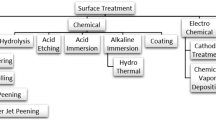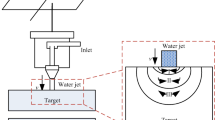Abstract
Abrasive waterjet peening (AWJP) has the advantages of water jet peening and shot peening, which is a potential comprehensive peening process for metals. In this paper, the multilevel energy decrement strategies were proposed and their effects on the surface roughness, hardness and residual stress were studied under different pressures and traverse speeds. The results showed that the pressure group had advantages in modifying the surface morphology of the workpiece compared with the speed group, which can improve the hardness and compressive residual stress of the workpiece while ensuring that the workpiece surface is relatively smooth to achieve a comprehensive strengthening effect. In the pressure group, the surface roughness of the sample after triple AWJP treatment is 3.018 μm, which is reduced by 40% compared to that of the single AWJP treatment. The maximum hardness can be up to 410.12 HV0.2, an increase of 27% compared to the original substrate. The depth of the hardened layer is about 110 μm, while the average hardness of the hardened layer is 397.24 HV0.2 and the maximum compressive residual stress can reach up to − 860.8 MPa.











Similar content being viewed by others
Data availability
All data generated or analyzed during this study are included in this published article.
References
Callegari B, Oliveira JP, Aristizabal K, Coelho RS, Brito PP, Wu L, Schell N, Soldera FA, Mücklich F, Pinto HC (2020) In-situ synchrotron radiation study of the aging response of Ti-6Al-4V alloy with different starting microstructures. Mater Charact 165:110400
Chakkravarthy V, Oliveira JP, Mahomed A, Yu N, Manojkumar P, Lakshmanan M, Lakshmanan M, Zhang L, Raja V, Jerome S, Prabhu T, Narayan RL (2023) Effect of abrasive water jet peening on NaCl-induced hot corrosion behavior of Ti–6Al–4V. Vacuum 210:111872
Lu H, Deng W, Luo K, Chen Y, Wang J, Lu J (2023) Tailoring microstructure of additively manufactured Ti6Al4V titanium alloy using hybrid additive manufacturing technology. Addit Manuf 63:103416
Teshome FB, Peng B, Oliveira JP, Shen J, Ao S, Li H, Chen L, Tan C, Song X, Zhou N, Zeng Z (2023) Role of Pd interlayer on NiTi to Ti6Al4V laser welded joints: microstructural evolution and strengthening mechanisms. Mater Des 228:111845
Gao Q, Liu H, Chen P, Liu X, Yang H, Hao J (2023) Multi-objective optimization for laser cladding refractory MoNbTiZr high-entropy alloy coating on Ti6Al4V. Opt Laser Technol 161:109220
Vantadori S, Vázquez Valeo J, Zanichelli A, Carpinteri A, Luciano R (2022) Structural integrity of shot peened Ti6Al4V specimens under fretting fatigue. Int J Fract 234(1–2):45–55
Zhang C, Hu K, Zheng M, Zhu W, Song G (2021) Effect of surface nanocrystallization on fatigue properties of Ti-6Al-4V alloys with bimodal and lamellar structure. Mater Sci Eng A 813:141142
Ongtrakulkij G, Khantachawana A, Kondoh K (2020) Effects of media parameters on enhance ability of hardness and residual stress of Ti6Al4V by fine shot peening. Surfaces Interfaces 18:100424
Liu Y, Li H, Li M (2020) Roles for shot dimension, air pressure and duration in the fabrication of nanocrystalline surface layer in TC17 alloy via high energy shot peening. J Manuf Process 56:562–570
Haghighi O, Amini K, Gharavi F (2020) Effect of shot peening operation on the microstructure and wear behavior of AZ31 magnesium alloy. Prot Met Phys Chem Surf 56:164–168
Ho H, Li D, Zhang E, Niu P (2018) Shot peening effects on subsurface layer properties and fatigue performance of case-hardened 18CrNiMo7-6 steel. Adv Mater Sci Eng 2018:3795798
Liao Z, Monaca A, Murray J, Speidel A, Ushmaev D, Clare A, Axinte D, M’Saoubi R (2021) Surface integrity in metal machining-Part I: fundamentals of surface characteristics and formation mechanisms. Int J Mach Tools Manuf 162:103687
Wagner L (1999) Mechanical surface treatments on titanium, aluminum and magnesium alloys. Mater Sci Eng A 263(2):210–216
Ming T, Xue H, Zhang T, Han Y, Peng Q (2022) Improving the corrosion and stress corrosion cracking resistance of 316 L stainless steel in high temperature water by water jet cavitation peening. Surf Coat Technol 438:128420
Wang Z, Liao Z, Axinte D, Dong X, Xu D, Augustinavicius G (2021) Analytical model for predicting residual stresses in abrasive waterjet peening. Mater Des 212:110209
Miao X, Long T, Wu M, Ma C, Wang Q (2022) Study on the process of abrasive water jet peening for 316L stainless steel. Int J Adv Manu Technol 120(11–12):8321–8328
Arola D, McCain ML (2000) Abrasive waterjet peening: a new method of surface preparation for metal orthopedic implants. J Biomed Mater Res Off J Soc Biomater Jpn Soc Biomater Austr Soc Biomater Korean Soc Biomater 53(5):536–546
Arola D, McCain ML, Kunaporn S, Ramulu M (2001) Waterjet and abrasive waterjet surface treatment of titanium: a comparison of surface texture and residual stress. Wear 249(10–11):943–950
Balaji DS, Jeyapoovan T (2021) Multi-objective optimization in abrasive water jet peening on AA6063 alloy. Mater Today Proc 45:1928–1933
Zhang P, Yue X, Wang P, Zhai Y (2022) Influence of SiC pellets water jet peening on the surface integrity of 7075–T6 aluminum alloy. Vacuum 196:110760
Fu H, Liang Y (2019) Study of the surface integrity and high cycle fatigue performance of AISI 4340 steel after composite surface modification. Metals 9(8):856–871
Jebaraj V, Bhagade A, Vijapuri D, Gupta E (2020) Influence of dual shot peening on the enhancement of surface characteristics of duplex stainless steel. Mater Today Proc 24:921–929
**e L, Wen Y, Wang L, Jiang C, Ji V (2016) Characterization on surface properties of Ti-6Al-4V after multiple shot peening treatments. J Eng Mater Technol 138(4):041005
Scuracchio BG, Lima NB, Schön CG (2013) Role of residual stresses induced by double peening on fatigue durability of automotive leaf springs. Mater Des 47:672–676
Zou Y, Xu Y, Li J, Liu S, Wang D, Li Y (2020) Evaluation of surface integrity in 18CrNiMo7-6 steel after multiple abrasive waterjet peening process. Metals 10(6):844–855
Azhari A, Schindler C, Godard C, Gibmeier J, Kerscher E (2016) Effect of multiple passes treatment in waterjet peening on fatigue performance. Appl Surf Sci 388:468–474
Lv J, Luo K, Lu H, Wang Z, Liu J, Lu J (2022) Achieving high strength and ductility in selective laser melting Ti-6Al-4V alloy by laser shock peening. J Alloy Compd 899:163335
Hensel J, Eslami H, Nitschke-Pagel T, Dilger K (2019) Fatigue strength enhancement of butt welds by means of shot peening and clean blasting. Metals 9(7):744–757
Mogul YI, Nasir I, Myler P (2020) Investigation and optimization for depth of cut and surface roughness for control depth milling in Titanium Ti6AL4V with abrasive water jet cutting. Mater Today Proc 28:604–610
Abushanab WS, Moustafa EB, Harish M, Shanmugan S, Elsheikh AH (2022) Experimental investigation on surface characteristics of Ti6Al4V alloy during abrasive water jet machining process. Alex Eng J 61(10):7529–7539
Standard I S (1998) 4287: 1997: Geometrical product specifications (GPS)-Surface texture: profile method-Terms, definitions and surface texture parameters, (No Title)
Wang P, Miao X, Wu M, Zhou P (2023) Study on the process of abrasive water jet cutting for zirconia ceramic tubes. Int J Adv Manuf Technol 126:5555–5569
Nordin E, Alfredsson B (2017) Experimental investigation of shot peening on case hardened SS2506 gear steel. Exp Tech 41:433–451
Ashrafizadeh F (2003) Influence of plasma and gas nitriding on fatigue resistance of plain carbon (Ck45) steel. Surf Coat Technol 174:1196–1200
Pour-Ali S, Kiani-Rashid AR, Babakhani A (2017) Surface nanocrystallization and gradient microstructural evolutions in the surface layers of 321 stainless steel alloy treated via severe shot peening. Vacuum 144:152–159
Tao X, Gao Y (2022) Effects of wet shot peening on microstructures and mechanical properties of a 2060–T8 aluminum–lithium alloy. Mater Sci Eng A 832:142436
Zhou W, Ren X, Liu F, Ren Y, Li L (2016) Nanocrystallization in the duplex Ti-6Al-4V alloy processed by multiple laser shock peening. Metals 6(12):297
Chakkravarthy V, Manojkumar P, Lakshmanan M, Prasad KE, Dafale R, Vadhana VC, Narayan RL (2023) Comparing bio-tribocorrosion of selective laser melted Titanium-25% Niobium and conventionally manufactured Ti-6Al-4V in inflammatory conditions. J Alloy Compd 952:169852
Acknowledgements
This research was supported by National Natural Science Foundation of China (52105346).
Funding
This research was supported by National Natural Science Foundation of China (52105346).
Author information
Authors and Affiliations
Ethics declarations
Conflict of interest
The authors declare no competing interests.
Code availability
The codes used or analyzed during the current study are available from the corresponding author on reasonable request.
Additional information
Technical Editor: Lincoln Cardoso Brandao.
Publisher's Note
Springer Nature remains neutral with regard to jurisdictional claims in published maps and institutional affiliations.
Rights and permissions
Springer Nature or its licensor (e.g. a society or other partner) holds exclusive rights to this article under a publishing agreement with the author(s) or other rightsholder(s); author self-archiving of the accepted manuscript version of this article is solely governed by the terms of such publishing agreement and applicable law.
About this article
Cite this article
Wang, P., Miao, X., Wu, M. et al. Research on the multilevel energy decrement strategy for abrasive waterjet peening Ti6Al4V. J Braz. Soc. Mech. Sci. Eng. 46, 79 (2024). https://doi.org/10.1007/s40430-023-04656-2
Received:
Accepted:
Published:
DOI: https://doi.org/10.1007/s40430-023-04656-2




